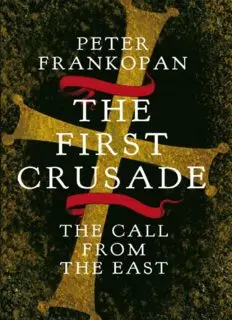
The First Crusade : The Call from the East PDF
Preview The First Crusade : The Call from the East
Contents Cover About the Book About the Author Praise List of Illustrations Maps Dedication Title Page Epigraph Preface and Acknowledgements Author’s Note Introduction 1. Europe in Crisis 2. The Recovery of Constantinople 3. Stability in the East 4. The Collapse of Asia Minor 5. On the Brink of Disaster 6. The Call from the East 7. The Response of the West 8. To the Imperial City 9. First Encounters with the Enemy 10. The Struggle for the Soul of the Crusade 11. The Crusade Unravels 12. The Consequences of the First Crusade Picture Section Abbreviations Notes Further Reading Index Copyright About the Book In 1096, an expedition of extraordinary scale and ambition set off from western Europe on a mass pilgrimage to Jerusalem. Three years later, after a journey which saw acute hardship, the most severe dangers and thousands of casualties, the knights of the First Crusade found themselves storming the fortifications and capturing the Holy City from its Muslim overlords. Against all the odds, the expedition had returned Jerusalem to Christian hands. With its themes of the rise of the papacy, the confrontation between Christianity and Islam, the evolution of the concept of holy war, of knightly piety and religious devotion, the First Crusade is one of the best known and most written about events in history. Yet in this fascinating and innovative study, Peter Frankopan shifts the perspective and asks vital questions that have never been posed before. Why was there an overwhelming desire to liberate Jerusalem in the mid-1090s, given that the city had been taken by the Muslims nearly 500 years earlier? What were the causes of the Crusade in the East which provoked such an overwhelming response in the West? What role was played by the Byzantine emperor in Constantinople in the genesis and execution of the expedition? In short, why was there a First Crusade? Rather than concentrating on the pope and the knights of western Europe who have dominated the history of the First Crusade for centuries, Frankopan focuses on Constantinople and the Byzantine Empire. He brilliantly restores the Emperor Alexios I Komnenos to the heart of the story, with a series of catastrophic events in the mid-1090s serving to paint a compelling and strikingly original picture of the expedition to Jerusalem that will change our understanding of the Crusades as a whole. About the Author Peter Frankopan is Senior Research Fellow at Worcester College, Oxford and Director of the Centre for Byzantine Research at Oxford University. He took a First in History and was Schiff Scholar at Jesus College, Cambridge before completing his doctorate at Oxford, where he was Senior Scholar at Corpus Christi College. He has lectured at leading universities all over the world, including Cambridge, Yale, Harvard, Princeton, NYU, King’s College London, and the Institute of Historical Research. His revised translation of The Alexiad by Anna Komnene was published in 2009. ‘A dazzling book, perfectly combining deep scholarship and easy readability. The most important addition to Crusading literature since Steven Runciman.’ John Julius Norwich, author of Byzantium ‘In this fluent and dramatic account, Peter Frankopan rightly places the Emperor Alexios at the heart of the First Crusade and in doing so skilfully adds a dimension frequently missing from our understanding of this seminal event. Frankopan illuminates the complex challenges that faced Alexios and deftly depicts the boldness and finesse needed to survive in the dangerous world of medieval Byzantium.’ Jonathan Phillips, author of Holy Warriors: A Modern History of the Crusades ‘Peter Frankopan’s reassessment of the Byzantine contribution to the origins and course of the First Crusade offers a compelling and challenging balance to traditional accounts. Based on fresh interpretations of primary sources, lucidly written and forcefully argued, The First Crusade: The Call from the East will demand attention from scholars while providing an enjoyable and accessible narrative for the general reader.’ Christopher Tyerman, author of God’s War: A New History of the Crusades ‘Filled with Byzantine intrigue in every sense, this book is important, compellingly revisionist and impressive in its scholarly use of totally fresh sources. It refocuses the familiar western story through the eyes of the emperor of the East and fills in the missing piece of the puzzle of the Crusades.’ Simon Sebag Montefiore, author of Jerusalem: The Biography List of Illustrations 1 Alp Arslan and Romanos IV after the battle of Manzikert (Bibliothèque nationale de France). 2 Christ and the Virgin Mary, mosaic in the south vestibule of Hagia Sophia, late tenth century (akg-images/Erich Lessing). 3 Reliquary for the wood from the True Cross, c.950 (akg-images/Erich Lessing). 4 The walls of Constantinople (akg-images/Gerard Degeorge). 5 Emperor Alexios I Komnenos (Vatican Library/Giraudon/Bridgeman Art Library). 6 Hyperpyron of Alexios I Komnenos, mint of Constantinople (The Barber Institute Coin Collection, University of Birmingham, B5543). 7 Pope Urban II arrives at the council of Clermont, from Le Roman de Godefroi de Bouillon, fourteenth century (Bibliothèque nationale de France/Giraudon/Bridgeman Art Library, Ms Fr 22495 f. 15). 8 Emperor Alexios receives Peter the Hermit (RMN, Château de Versailles/Gérard Blot). 9 The Crusaders at Nicaea, 1097, from Estoire d’Outremer by William of Tyre, twelfth century (Bibliothèque nationale de France/Bridgeman Art Library, Fr 2630 f. 22v). 10 The siege of Antioch, 1097–8, from Estoire d’Outremer by William of Tyre, twelfth century (Bibliothèque municipale de Lyon/Bridgeman Art Library, Ms 828 f. 33r). 11 The massacre at Antioch, 1098 (Bibliothèque nationale de France). 12 The Crusader assault on Jerusalem, 1099 from Le Roman de Godefroi de Bouillon, fourteenth century (Bibliothèque nationale de France/Bridgeman Art Library, Fr 22495 f. 69v). 13 The looting of Jerusalem, 1099, illuminated miniature from a universal chronicle, fifteenth century (Bibliothèque nationale de France/Bridgeman Art Library, Fr 20124 f. 331).
